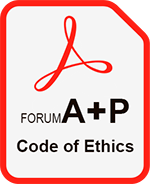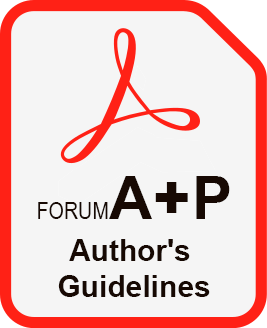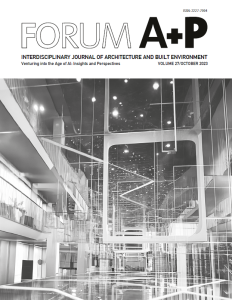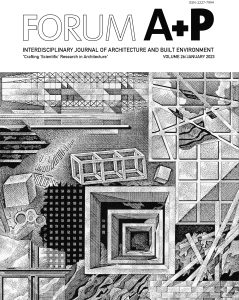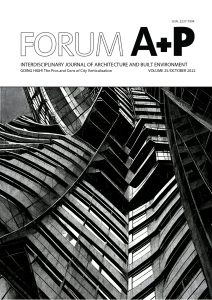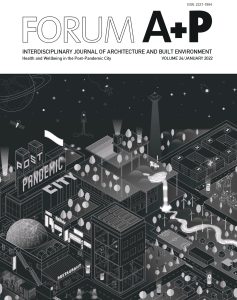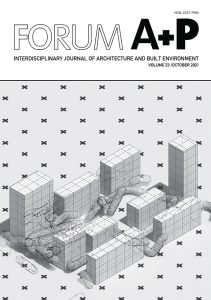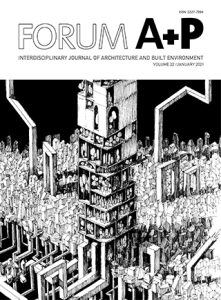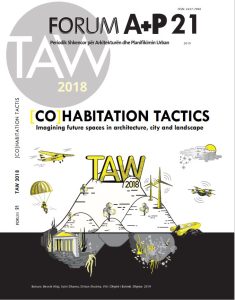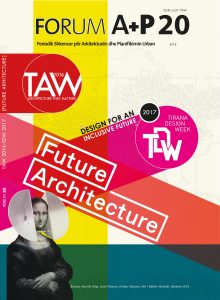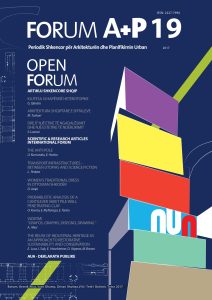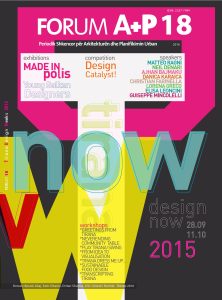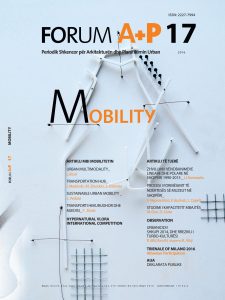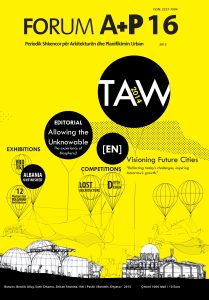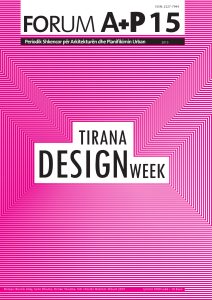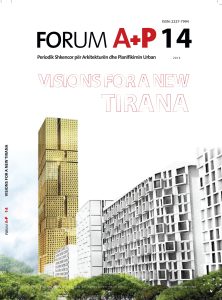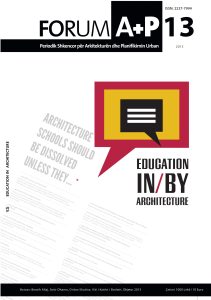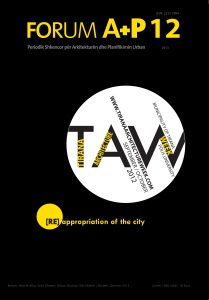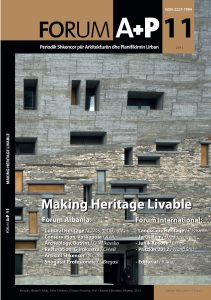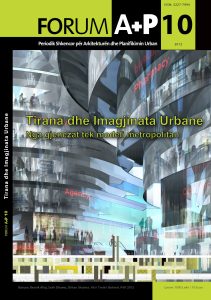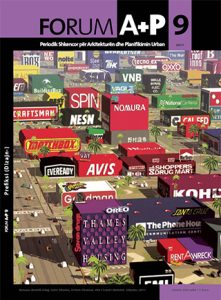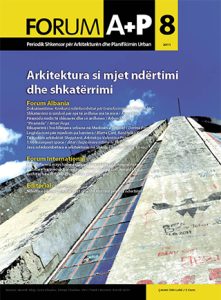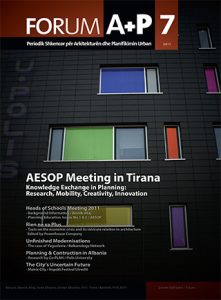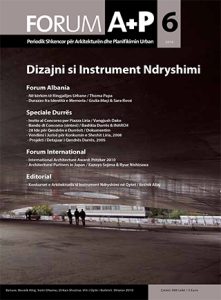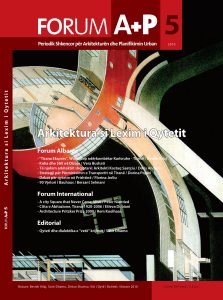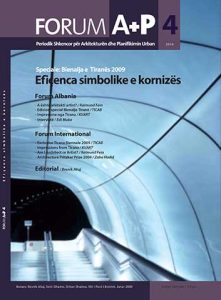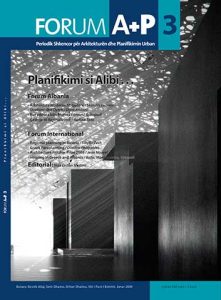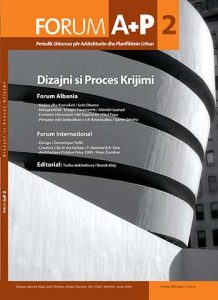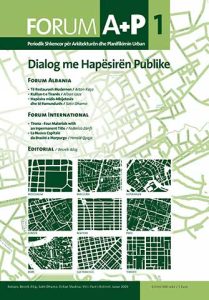POLIS University publishes the “Forum A+P” journal, the only scientific and cultural magazine in the Albanian –speaking countries for the fields of architecture and territory planning. This magazine is recognized by the Ministry of Education and Science, the Academic Degrees Evaluation Committee and has an ISSN international registration code in France. The magazine is published in Albanian and English language and contains a package of scientific, informative articles and analysis. This Articles are instead made available under a Creative Commons license (CC-BY-NC-SA 4.0) to allow others to freely access, copy and use research provided the author is correctly attributed. Creative Commons licenses are likely to be added to the article by the journal/publisher, but you should check with them when submitting. As you retain the copyright, you would be able to use the final published version of the article in any way you wished. All the articles are indeed released under the Open Access protocol.
FORUM A+P was established in 2009. FORUM A+P is a biannual open access peer-reviewed journal and is the only scientific and cultural magazine in the Albanian–speaking countries for the fields of architecture and territory planning. This magazine is recognized by the Ministry of Education and Science, the Academic Degrees Evaluation Committee and has an ISSN international registration code in France. FORUM A+P has currently completed 14 years of operation with 25 successful issues and the 26th issue underway.
With a focus on architecture and territory planning FORUM A+P aspires to offer a forum for recording and building common grounds under this methodological and thematic polyphony.
Aim and Scope
FORUM A+P Code of Ethics (“Journals Code of Ethics”) is binding on all persons involved in matters or activities involving the Journal.
The scope of the FORUM A+P’s Scientific Journals’ Code of Ethics does not apply to matters and activities involving non-Journal member. However, members in good standing are expected to know the Journals Code of Ethics and, where appropriate, to follow these policies for peer review and publication ethics in all their scholarly publication.
FORUM A+P aims are related to:
- Promotion of Albanian Architecture: FORUM A+P aims to showcase and celebrate the rich architectural heritage of Albania, from historic landmarks to contemporary designs, fostering a deeper appreciation for the country’s unique architectural identity.
- Encouragement of Innovative Design: The journal seeks to inspire architects and urban planners to push boundaries and explore innovative solutions that address present-day challenges, while respecting cultural and environmental contexts.
- Sustainable Urban Development: FORUM A+P aims to advocate for sustainable practices in urban planning and architecture, promoting environmentally responsible designs that minimize the ecological footprint and contribute to a greener future for Albania.
- Preservation of Cultural Heritage: The journal aspires to be a platform for discussions on the preservation and restoration of cultural heritage sites and buildings, ensuring that the essence of Albanian history and culture is safeguarded for future generations.
- Interdisciplinary Exchange: FORUM A+P seeks to foster collaboration and interdisciplinary exchange between architects, urban planners, landscape architects, historians, sociologists, and other professionals to address the multifaceted challenges of urban development.
Regarding the scopes and interests of the journal, it is worthy to mention:
- Architectural Design: The journal welcomes submissions showcasing exceptional architectural designs, whether conceptual or realized, ranging from residential, commercial, public, or institutional projects.
- Urban Planning and Development: FORUM A+P invites articles that discuss urban planning strategies, policies, and projects that aim to create livable, inclusive, and resilient urban environments across Albania and not only.
- Sustainable Architecture: The journal encourages research on sustainable building materials, energy-efficient designs, renewable energy integration, and green infrastructure to promote eco-friendly construction practices.
- Historical and Cultural Studies: FORUM A+P accepts contributions exploring the historical and cultural significance of architectural landmarks and their impact on shaping Albanian society.
- Urban Renewal and Regeneration: Submissions focusing on urban regeneration, adaptive reuse, and revitalization projects are invited to promote the enhancement of existing urban areas.
- Landscape Architecture: The journal welcomes articles on landscape design, urban parks, green spaces, and their role in enhancing the quality of life in contemporary cities.
- Digital and Technological Innovations: FORUM A+P aims to feature research on the integration of digital tools, advanced technologies, and parametric design in architecture and urban planning.
- Community Participation: The journal encourages studies that highlight the importance of involving local communities in the planning and design process, fostering a sense of ownership and identity in urban spaces.
- Case Studies and Best Practices: Authors are encouraged to present case studies and best practices from Albania and beyond, offering valuable insights for architects and urban planners facing similar challenges.
- Policy and Legislation: FORUM A+P invites analyses and discussions on relevant policies, regulations, and legal frameworks related to architecture and urban planning in Albania and with a broader focus on the Mediterranean Region.
By encompassing these aims and scopes, FORUM A+P aims to contribute significantly to the advancement and understanding of the built environment in Albania, facilitating a sustainable and culturally enriched future for the country.
Within this framework, FORUM A+P invites contributions based on the broader domain of architecture, and its affiliations with architectural design, the ethics, politics and aesthetics of architecture, building technology, computation, history, theory, arts, product design, conservation, landscape design, environmental design, urbanism, regional planning and town planning. Each issue features five articles and a “Telqel Architecture section” featuring thoughts and ideas from some established scholars setting the stage for the journal’s theme.
FORUM A+P is an open access journal which means that all content is freely available withouth charge to the user or his/her institution. Users are allowed to read, download, copy, distribute, print, search, or link to the full texts of the articles, or use them for any other lawful purpose, without asking prior permission from the publisher or the author. This is in accordance with the BOAI definition of open access.
Our journal website upholds a commitment to accessibility by refraining from imposing any fees for the submission of scholarly papers, ensuring an inclusive platform for academic contributions.
BOARD OF DIRECTORS INSTITUTION
PhD Doc. Sotir Dhamo // POLIS University (AL)
Prof. Dr. Besnik Aliaj // POLIS University (AL)
PhD Dritan Shutina // Co-Plan (AL)
EDITORIAL COMMITTEE
Head of the Editorial Committee
PhD Ledian Bregasi // POLIS University (AL)
Assoc. Prof. Andrew Charleson // Victoria University (NZ)
Reader, PhD Antonino Di Raimo // Portsmouth University (UK)
PhD Elona Karafili // POLIS University (AL)
PhD Matevž Čelik // Future Architecture
Programme Director (SVN)
Emer. Prof. Michael Batty // Bartlett (UK)
Prof. PhD Michelangelo Russo // Federico II (IT)
Prof. PhD Roberto Di Giulio // UniFe (IT)
PhD Skender Luarasi // POLIS University (AL)
PhD Sonia Jojic // POLIS University (AL)
PhD Valerio Perna // POLIS University (AL)
SCIENTIFIC COMMITTEE
Asst. Prof. PhD Anastasios Tellios // AUTh (GR)
PhD Endrit Marku // POLIS University (AL)
Emer. Prof. Franco Purini // Sapienza (IT)
Assoc. Prof. PhD Giuseppe Mincolelli // UniFe (IT)
Assoc. Prof. PhD Kiersten Muenchinger // UO (USA)
Assoc. Prof. PhD Kostandinos Giakoumis // K. Logos (AL)
Srlect. PhD Loris Rossi // MMU (UK)
PhD Peter Nientied // Hogeschool NCOI (NL)
PhD Rudina Toto // CO-Plan (AL)
Assoc. Prof. PhD Theo Zaffagnini // UniFe (IT)
EDITORIAL TEAM
MSc Kristiana Meço // POLIS University (AL)
Licence Details
For the research field classification on Polis Press, and on the FORUM A+P Journal, we follow the International Standard Classification of Education (ISCED). These Articles are instead made available under a Creative Commons license (CC-BY-NC-SA 4.0) to allow others to freely access, copy and use research provided the author is correctly attributed. Creative Commons licenses are likely to be added to the article by the journal/publisher, but you should check with them when submitting. As you retain the copyright, you would be able to use the final published version of the article in any way you wished.
All the articles are indeed released under the Open Access protocol. Copyright © 2022 by author(s) and POLIS_Press. This work is licensed under the CreativeCommons Attribution InternationalLicense (CC-BY-NC-SA 4.0). https://creativecommons.org/licenses/by-nc-sa/4.0/
Copyright Policy
The FORUM A+P journal is offered in a downloadable form for academic and research purposes only. All material published in each issue is, unless otherwise stated, the property of the authors of the respective articles. The reproduction of an article in whole is only allowed with the written consent of the author. Any reproduction of the material in parts, in any manner, should properly credit the copyright holder. A single copy of the materials available in each issue may be made for personal, noncommercial use.
Please submit your contributions to [forumap@universitetipolis.edu.al]
Plagiarism and Self-Plagiarism
All work in the manuscript should be free of any plagiarism, falsification, fabrications, or omission of significant material.
Plagiarism takes many forms, from deliberately misrepresenting another’s paper as the Author’s own paper, to copying or paraphrasing substantial parts of another’s paper without attribution, to claiming results from research conducted by others. Authors are expected to explicitly cite others’ work and ideas, even if the work or ideas are not quoted verbatim or paraphrased. This standard applies whether the previous work is published, unpublished, or electronically available. Plagiarism in all its forms constitutes unethical publishing behavior and is unacceptable.
Redundancy (or “self-plagiarism”) is unacceptable publishing behavior. Redundancy can occur in at least two ways: (1) Authors recycle portions of their previous writings by using identical or nearly identical sentences or paragraphs from earlier writings in subsequent research papers, without quotation or acknowledgement; or (2) Authors create multiple papers that are slight variations on each other, which are submitted for publication in different journals but without acknowledgement of the other papers. Authors can and often do develop different aspects of an argument in more than one manuscript. However, manuscripts that differ primarily in appearance, but are presented as separate and distinct research without acknowledging other related work, constitute attempts (whether unintentional or deliberate) to deceive reviewers and readers by overinflating the intellectual contribution of the manuscript. Since publication decisions are influenced by the novelty and innovativeness of manuscripts, such deception is inappropriate and unethical.
Authors should minimize their recycling of previous writings. If recycling is unavoidable, the Author should inform the Editor at the time of submission and reference the previous writings in the manuscript. Such self-referencing should be worded carefully to avoid compromising the double-blind review process.
Background/Structure
The COPE Code of Conduct for Journal Editors is designed to provide a set of minimum standards to which all COPE members are expected to adhere. The Best Practice Guidelines are more aspirational and were developed in response to requests from editors for guidance about a wide range of increasingly complex ethical issues. While COPE expects all members to adhere to the Code of Conduct for Journal Editors (and will consider complaints against members who have not followed it), we realize that editors may not be able to implement all the Best Practice recommendations (which are therefore voluntary), but we hope that our suggestions will identify aspects of journal policy and practice that should be reviewed and discussed. In this combined version of the documents, the mandatory Code of Conduct for Journal Editors standards are shown in regular script and with numbered clauses, and the more aspirational Best Practice recommendations are shown in italics.
Conflicts of Interest
Authors should avoid conflicts of interest or the appearance of conflicts of interest throughout the research process. A conflict of interest is some fact known to a participant in the publication process that if revealed later, would make a reasonable reader feel misled or deceived (or an Author, Reviewer, or Editor feel uncomfortable as to the integrity of the process). Conflicts of interest may influence the judgment of Authors, Reviewers, and Editors. Possible conflicts often are not immediately apparent to others. They may be personal, commercial, political, academic, or financial. Examples of financial interest conflicts may include employment, research funding (received or pending), stock or share ownership, patents, payment for lectures or travel, consultancies or non-financial support.
Single-Blind Review
FORUM A+P uses single-blind peer review. This means both the reviewer and author identities are
hidden from one another during every step of the process. Authors will need to prepare their manuscript in a way that does not expose any identifying information. Identifying information most commonly refers to authors’ names and institutions, as well as any photos of the authors. These are mandatory requirements to be considered for publication in the journal.
Copyright Law
Authors should check their manuscripts for possible breaches of copyright law (e.g., where permissions are needed for quotations, artwork, tables or any protected content taken from other publications) and secure the necessary permissions before submission.
Authors should avoid anything in the text of the manuscript that might be actionable, such as defamation. Authors should avoid using sexist and biased language that could be interpreted as denigrating to ethnic or other groups; for example, plural rather than single pronouns (“they” rather than “he”) are recommended.
For further additional information, kindly download the complete document below.
Authors
FORUM A+P Scientific Journal accepts only two types of manuscripts: Peer-reviewed and Solicited. All manuscripts will go through a ‘single-blind peer review’ process before being accepted for publication.
Solicited manuscripts are sent directly to the editors. Un-solicited manuscripts in the below categories are sometimes accepted, but please consult with Head of the Editorial Committee, Dr. Ledian Bregasi – Polis University Dean of the Faculty of Architecture and Design.
Reviewing Policy
The peer reviewers are all confirmed educators of architecture coming from different educational backgrounds, with different specialisations and expertise that share the common interest of the journal mission: to encourage and improve the thinking processes towards academic research writings in the fields of architecture and territory planning. Each submitted article is reviewed by one member of the journal’s Scientific Committee anonymously.
Journal Repository Policy
FORUM A+P encourages authors to submit their published articles to institutional repositories with no embargo; The only compulsory condition is to include a link to the published article and that the version used is the final published one developed after the peer reviewing process.
As so they are allowed institutional repositories that are operated by domestic and foreign universities and non-profit research institutions, websites of research funding organizations that have provided support for the article, author’s Web site, and non-commercial online thesis archives.
The journal typically seeks submissions based on a specific theme. For guidance on whether a subject is appropriate for FORUM A+P Scientific Journal, please write directly to the Head of the Editorial Committee, Dr. Ledian Bregasi – Polis University Dean of the Faculty of Architecture and Design.
Guidelines for Authors
The article manuscript file must be provided in either DOCX or LaTeX format with all comments and edits resolved/accepted. We will not typeset a manuscript that still contains review markup.
Note: LaTeX submissions must include a compiled PDF of the article, as well as a BibTeX file of the references cited.
You should include the title, your information, an abstract of maximum 400 words and maximum 5 keywords. Also the body of the main text of course, and your references. It should not include images, but rather a placeholder (in the form of a short sentence, like image01 etc) indicating clearly the place in the text where an image should appear, along with its caption. Therefore, the submitted text should include the following parts (please take a look at the previous issue in order to better understand the way the journal will be structured):
- Abstract (max 400 words)
- Key-words (max 5)
- Main text
— Section titles (numbered)
The text should not have any formatting since this will be handled by the editorial team in Indesign where the final layout will be created. You can use any font that you want, but it is highly advisable that the font – along with any other properties of the font and the paragraph – are adjusted globally through the style used (for example Normal, Body text, etc) and are not applied directly on separate selections of the text.
A folder containing all images to be included along with the text. The names of the files should correspond with the placeholder text that is part of the .doc file.For each article only a maximum of 5 B/N images is allowed. Images should be delivered in .jpeg format with a minimum resolution of 300dpi and a minimum width of 16cm.
A .pdf file containing everything that is part of the .doc file and the images at the places where they should be displayed. The pdf is going to be used only as a reference for the layout. The actual text used will be copied from the .doc file and the images imported from the image folder.
A .doc file containing a short bio of the author of maximum 200 words.
Notes:
References should follow this version of the APA (7th edition).
For any secondary text please choose footnotes instead of endnotes and use the build-in functionality of your word-processor.
All works cited within the article should be included in the reference list. If more than five cited works are missing from the reference list, the typesetting team may need to request these missing references from the author before completing the article proof. This is likely to delay the typesetting process.
Tables
Tables should be embedded inside the main article file. Tables must be editable, cell-based objects.
Text formatting guidelines for tables
- Use only separate cells, ordered lists, or unordered lists to separate content within the same cell into individual lines. Do not use spaces, tabs, html tags, or manual line breaks inside a table.
- Symbols indicating statistical significance should appear in the same cell as the value and should not have their own column.
- To highlight individual values in tables, you may use boldface type, italic type, or a single color of shading (note: the shading color is standardized so will not exactly match what you provide). Do not use multiple colors of shading, underline, or font size to highlight values in tables. Do not use color to indicate meaning.
- Text color is limited to black.
More info regarding the guidelines for authors and types of contribution accepted from the journal can be found at the following link:
For further additional information, kindly download the complete document below.
Open Call for Articles for the FORUM A+P
Interdisciplinary Journal of Architecture and Built Environment
Theme issue 29: “Urban Sustainability and Resilience in the context of the 21st century challenges”
Deadline: 1 July 2024
Editors:
Llazar Kumaraku, Skender Luarasi, and Doriana Musaj.
Welcome to our open call for articles for the Forum A+P issue 29 “Interdisciplinary Journal of Architecture and Built Environment”. We invite all researchers, architects, urban planners, and enthusiasts to submit their original research and scientific articles no later than 10 June 2024v.
Theme:
The Forum AP #29 is centered around the pivotal theme of urban sustainability and resilience. This multifaceted theme invites exploration across a spectrum of dimensions, encompassing formal, functional, social, economic, and environmental aspects.
Recognizing the interdisciplinary nature of this theme, we warmly invite participation from experts, researchers, and academics across diverse disciplines whose work intersects with urban sustainability and resilience. This issue presents a unique opportunity to engage in a rich, multidimensional dialogue on the pressing challenges and innovative solutions in the realm of urban sustainability and resilience. We invite you to submit your full paper that contribute to this theme. The topics of interest include, but are not limited to:
– Formal Sustainability
This subtheme explores the physical and spatial aspects of urban sustainability. It delves into the design, planning, and architectural practices that contribute to the creation of sustainable and resilient urban forms.
– Resilience and Economic Sustainability
This subtheme focuses on the economic factors and functional programs that drive urban sustainability. It examines the role of economic policies, market mechanisms, and functional programs in promoting sustainable urban development.
– Social Sustainability
This subtheme addresses the social dimensions of urban sustainability. It investigates how social equity, inclusivity, and community engagement can be fostered in urban settings to ensure a sustainable and resilient future.
– Environmental Sustainability and Green Transition
This subtheme centers on the environmental aspects of urban sustainability and the transition towards greener urban environments. It looks at strategies for mitigating environmental impacts, promoting biodiversity, and transitioning to low-carbon and resource-efficient urban systems.
– Sustainability of Urban Policy and Governance
This subtheme discusses the role of policy and governance in urban sustainability. It considers how effective policy-making, governance structures, and institutional practices can support the implementation of sustainability and resilience strategies in urban areas.
Submission Guidelines
- Article Length: Articles should be between 7000 and 10000 words, including abstracts, references and image captions.
- Abstract: Each submission should include an abstract between 300-350 words.
- Keywords: Please include 4-6 keywords.
- References: All references should follow the APA Referencing Style (7th edition)..
- Figures and Tables: All figures and tables should be B/W, high-resolution and appropriately labeled.
Review Process
All submissions will undergo a single-blind peer review process. The review process may take up to 3 months.
Submission Deadline
The deadline for submissions is 1 July 2024.
How to Submit
Submissions should be sent as a Word document to forumap@universitetipolis.edu.al. Please include “Article Submission: [Your Article Title]_[Author/s Surnames]” ” in the email subject line.
Contact:
If you encounter any technical difficulties or have questions related to the submission process, please feel free to contact us at forumap@universitetipolis.edu.al for assistance. Please put in CC llazar_kumaraku@universitetipolis.edu.al; skender_luarasi@universitetipolis.edu.al; doriana_musaj@universitetipolis.edu.al and Valerio_perna@universitetipolis.edu.al.
We look forward to your contributions!
Best regards,
Llazar Kumaraku; Skender Luarasi; Doriana Musaj
Guest Editors: Forum AP 29
Submission policy
FORUM A+P is published two times a year. The official language of the journal is English. Submitted manuscripts for review should not exceed 7000-10000 words, including abstracts, references and image captions. The referring system will be the APA Style (7th edition). Text should be saved in a Microsoft Word or RTF file, while the supporting visual material (images, diagrams, sketches, tables and so on) should be sent as JPEG files with a resolution of at least 300 dpi (b/n format). All visual material should be clearly indicated and numbered in the text, along with the respective image captions and credits.
No fee is charged from the authors during the submission, evaluation and publication process
Submission Format
We are excited to welcome your submissions for our upcoming issue. To ensure a smooth and efficient paper submission process, please use the designated email address provided below for all paper submissions: Email Address: forumap@universitetipolis.edu.al
Here are a few important points to keep in mind when submitting your papers via email:
-Use the Subject Line: When sending your email, please use a clear and specific subject line that includes the name no. of the volume and the title of your paper. This will help us in organizing and processing your submission promptly.
-Required Attachments: Ensure that your paper and any required documents (such as an abstract, cover letter, or author information) are attached to the email. Follow the submission guidelines provided in the call for papers.
-Contact Information: Include your contact information within the body of the email, such as your full name, affiliation, and a reachable phone number.
-Confirmation of Receipt: Upon successful submission, you will receive an acknowledgment email to confirm that your paper has been received. If you do not receive this confirmation within a reasonable timeframe, please contact us.
-Technical Issues: If you encounter any technical difficulties or have questions related to the submission process, please feel free to contact us at forumap@universitetipolis.edu.al for assistance.
We appreciate your interest and look forward to receiving your submissions. If you may have any questions or need further assistance, do not hesitate to reach out to us at forumap@universitetipolis.edu.al
Thank you for your participation, and we look forward to your submissions.
Call for Paper – FORUM A+P 27
Guest editors
Dr Ledian Bregasi
Dr Valerio Perna
In recent times, the term “intelligence” has gained considerable popularity, permeating numerous spheres encompassing actions, practices, processes, and products. This pervasive presence within contemporary discourse can be attributed to two pivotal factors. Primarily, there has been a paradigmatic shift in our comprehension of intelligence, transcending the notion of it being exclusively confined to humans, but rather acknowledging its manifestation in diverse emerging properties and conditions present in both human and non-human entities. Secondly, intelligence is now perceived as a multifaceted nexus, interlinking a ‘brain’ (whether human or non-human), a corporeal form, and the complex environmental contexts in which this embodiment exists.
Within architectural circles, there is an ongoing exploration of various “intelligent” tools, encompassing diverse AI languages, generative adversarial networks, and text-to-image tools. These endeavors seek to comprehend how non-human intelligence can be harnessed to address contemporary urban challenges and concerns. Simultaneously, careful consideration is being given to the potential benefits and risks that arise from the utilization of such tools in urban centers and cities.
The field of architecture is undergoing rapid transformation due to the incorporation of cutting-edge digital technologies, particularly the integration of artificial intelligence (AI) into various aspects of design, representation, and production. Considering the already substantial impact of AI in fields such as engineering, social sciences, and political sciences, it becomes imperative for architecture to adopt a critical approach in understanding and evaluating the implications of these transformative technologies within its own domain. By doing so, architecture can effectively navigate and harness the potential benefits while addressing any challenges that may arise from the integration of AI in its practices.
The application of Artificial Intelligence (AI) techniques has witnessed widespread use in the realm of architecture, particularly within design-related domains. The emergence of AI-based design methods has led to a growing trend among researchers and architects, who are now actively engaged in training machine learning models or leveraging pre-trained models to augment the architectural design process. This integration of AI technology encompasses a wide array of functionalities, ranging from generating design renderings based on images to optimizing design solutions through vector-based approaches. By leveraging AI, the early-stage design inspiration phase is enriched with heightened creativity, while the efficiency of the overall design process is significantly enhanced. The fusion of AI with architectural practices thus paves the way for innovative and streamlined design solutions, fostering a promising outlook for the future of architecture.
In his seminal work, the Tractatus Logico-Philosophicus (1922), Ludwig Wittgenstein put forth the notion that the boundaries of one’s language mark the boundaries of one’s understanding of the world. This perspective suggests that if we lack the linguistic capacity to articulate something, then it is deemed nonexistent or incomprehensible. However, in the contemporary landscape, Wittgenstein’s statement acquires a new dimension as we witness the emergence of natural language text-to-image applications driven by artificial intelligence algorithms. This development prompts profound reflections on the concept of a post-digital sensibility in architecture.
The exploration of a post-digital sensibility in architecture involves investigating how natural language-based AI applications can transcend traditional boundaries, and through theoretical and practical approaches, delve into the realms of creativity and intelligence within a post-human design ecology. By utilizing Neural Network processes in design, this discourse seeks to dispel the perceived ‘risks’ associated with such technological advancements and unlock new possibilities for architectural expression and exploration.
Through the convergence of AI-driven text-to-image tools and architectural practice, this inquiry into a post-digital sensibility envisions a future where the conventional barriers between language, creativity, and design are dismantled. By embracing and demystifying AI’s potential, architects can forge innovative paths to shape the built environment in ways previously unimagined.
In light of these foundational ideas, FORUM A+P is calling for contributions from academics, researchers, and PhD students who have explored these concepts in their doctoral theses as solo authors. We invite essays that center on any field related to the emergent transformative possibilities, projects, and research that not only push the boundaries of design and production but also redefine the discipline through the integration of AI and robotic technologies.
The focus of these essays should be on critically examining the inherent social, cultural, and racial biases that are often intertwined within the data fueling this new field. As AI and robotic technologies increasingly influence architectural practice, it is crucial to address the ethical implications and potential biases that may emerge from their implementation. We seek contributions that engage in a thought-provoking and in-depth analysis of how these transformative technologies impact the discipline of architecture and its broader societal context.
Researchers and scholars are encouraged to submit essays that shed light on the novel perspectives and approaches these technologies bring to architectural design, exploring their potential to revolutionize the field while remaining mindful of the ethical considerations that arise. By fostering a critical dialogue, this issue aims to foster a deeper understanding of the implications and challenges posed by AI and robotic technologies within architecture, and to advance a more inclusive and socially conscious architectural practice.
Forum A+P email: forumap@universitetipolis.edu.al
Head of Editorial Board // Dr. Ledian Bregasi: ledian_bregasi@universitetipolis.edu.al
Rruga Bylis 12, Autostrada Tiranë-Durrës, Km 5, Kashar, SH2, Tiranë 1051
Tiranë
Albania
E-ISSN:2227-7994

